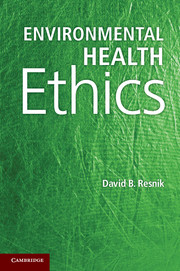Book contents
- Frontmatter
- Contents
- Figures and Tables
- Acknowledgments
- Abbreviations
- 1 Introduction
- 2 An Overview of Environmental Health
- 3 Ethical Theory
- 4 Toward an Environmental Health Ethics
- 5 Pest Control
- 6 Genetic Engineering, Food, and Nutrition
- 7 Pollution and Waste
- 8 The Built Environment
- 9 Climate Change, Energy, and Population
- 10 Justice and Environmental Health
- 11 Environmental health Research Involving Human Participants
- 12 Conclusion
- References
- Index
9 - Climate Change, Energy, and Population
Published online by Cambridge University Press: 05 July 2012
- Frontmatter
- Contents
- Figures and Tables
- Acknowledgments
- Abbreviations
- 1 Introduction
- 2 An Overview of Environmental Health
- 3 Ethical Theory
- 4 Toward an Environmental Health Ethics
- 5 Pest Control
- 6 Genetic Engineering, Food, and Nutrition
- 7 Pollution and Waste
- 8 The Built Environment
- 9 Climate Change, Energy, and Population
- 10 Justice and Environmental Health
- 11 Environmental health Research Involving Human Participants
- 12 Conclusion
- References
- Index
Summary
This chapter will examine ethical and policy issues related to three global environmental health topics: climate change, energy use and production, and population. These issues are global in scope because they affect everyone on the planet and require international cooperation for their resolution. The issues are also fundamentally interconnected because increases in population lead to greater demands for energy, which can impact climate change.
CLIMATE CHANGE
We have already mentioned climate change due to global warming during the discussion of air pollution in Chapter 7, meat eating in Chapter 6, and urban sprawl in Chapter 8. In this chapter, we will explore the topic in greater depth. A primary mechanism for global warming is the greenhouse effect, which occurs when radiant heat entering an enclosed area through a transparent medium is trapped, which raises the temperature. A variety of gases present in the atmosphere, including carbon dioxide (CO2), methane, ozone, water, and nitrous oxide, trap the sun’s heat by absorbing infrared radiation reflected by the surface of the Earth and re-emitting it. Sources of greenhouse gases include volcanic activity, decaying vegetation, animal respiration and waste, combustion of biomass and fossils fuels, and industrial processes, such as cement manufacturing. Without any greenhouse gases, the Earth would be too cold to support life as we know it (National Aeronautics and Space Administration 2010a).
- Type
- Chapter
- Information
- Environmental Health Ethics , pp. 171 - 201Publisher: Cambridge University PressPrint publication year: 2012
- 1
- Cited by

